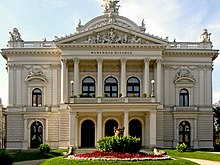Mahen Theater
The Mahen Theater ( Mahenovo divadlo ) in Brünn / Brno is a historical-style theater building designed by the architects Fellner and Helmer .
history
The house, which was initially built as the German City Theater , was built in the wake of the deconsolidation of Brno carried out in 1861–1863 and the establishment of a ring road (based on the Viennese model) on the fruit market (today: Malinovsky Square ). Until 1918 and during the Protectorate it had the function of playing in German for the German-speaking population, while the theater on Eichhorngasse served as the Czech National Theater at that time . Subsequently, this representative house took over the function of the Czech National Theater and was initially called Theater on the Schanzen (1918–1945), then Janáček Opera (1945–1946), Janáček Theater (1946–1965) and today (since 1965) to Jiří Mahen .
Mayor Gustav Winterholler was the driving force behind the prestigious cultural project. The commission was given to the renowned Viennese theater architect Ferdinand Fellner jun. and Hermann Helmer awarded; construction began on July 18, 1881; Goethe's Egmont was performed at the opening on October 30, 1882 .
The rich sculptural decoration of the theater building is the work of Theodor Friedl (1842–1900) from Vienna , who worked regularly with Fellner and Helmer. For the steps of the main staircase, marble - the most beautiful Stefanos stone - was used, for the stairs from the ground floor to the first floor, hard Kaiserstein from the quarry in Kaisersteinbruch was chosen , and for the gallery stairs , Brünnlitzer Stein. The Viennese sculptor Franz Schönthaler (1821–1904) created the figure group of the attic from Breitenbrunn stone . The allegorical ceiling paintings in the auditorium are by Julius Schmid (1854–1935) from Vienna and Olga Fialková (1848–1930); the curtain was designed by Franz Lefler (1831–1898).
The City Theater in Brno was the first to be built free-standing after the increased safety regulations following the fire in the Ring Theater (1881) . As a result, it was the first fully electrically lit theater on the European continent. A steam power station was built for the lighting in Offermann Street, now Vlhká Street, after Thomas Alva Edison's assistant , Francis Jehl , came to Brno in 1882 to design and install the electrical lighting for the theater.
In 1971–1978 the building, which until then had essentially existed in its original form and with its original technical equipment, was subjected to a total renovation in line with historic monument regulations. Parts of the architecture and decoration have been restored and missing details have been replaced with copies of preserved original fragments. A new interior design, designed by the Brno architect Jindrich Kumpost jun., Includes lighting fixtures, a buffet counter, showcases, armchairs, loudspeakers and radiator cladding. Instead of the original 1195 seats, there are now comfortable 572 seats.
In 1987 the Divadélko Na Hradbách opened under the stage of the Mahen Theater (again called the small theater on the hill ). This room with a small auditorium serves as a one-man stage and as a location for other small cultural events.
Maria Jeritza and Leo Slezak, among others, began their careers at this theater.
literature
- Gerhard Michael Dienes (ed.): Fellner & Helmer - the architects of illusion. Theater construction and stage design in Europe, on the occasion of the “100 Years of Graz Opera” anniversary. Stadtmuseum Graz, Graz 1999, ISBN 3-900764-21-2 .
- Hans-Christoph Hoffmann: The theater buildings by Fellner and Helmer. Prestel, Munich 1966.
- Eduard Steiner: The Brno people and their city theater. Brno Heimatbote, Leimen 1964.
Individual evidence
- ↑ a b Dienes: Fellner & Helmer. P. 143.
- ^ Helmuth Furch : Former German city theater in Brno, stone masonry Kaisersteinbruch and Breitenbrunn. In: Museum and Culture Association Kaisersteinbruch (ed.): Messages from the Museum and Culture Association Kaisersteinbruch. No. 46. Kaisersteinbruch 1997, pp. 36-44 ( permalink.obvsg.at ). ISBN 978-3-9504555-3-3 .
- ^ Archives of the City of Brno, registry 1851–1896, box 465, inventory number 1366.
- ↑ Brno City Theater: groups of figures made of neogene lime sandstone from Breitenbrunn, steps and stairs made of nullipore lime from Kaisersteinbruch, plinths, columns and parapets made of quartz sandstone from Wildenschwert and Brüsau. Steps of the ramp made of ashlar sandstone from Skalitz, log stairs made of chalk limestone from Istria. In: Felix Karrer : Guide through the building material collection of the Imperial and Royal Natural History Court Museum. Lechner, Vienna 1892, ( permalink.obvsg.at ).
- ^ Dienes: Fellner & Helmer. P. 144.
- ↑ a b c Dienes: Fellner & Helmer. P. 145.
Remarks
- ↑ The office, which had specialized in the planning of theater buildings, was active throughout Europe and built, among other things, German-language theaters in Reichenberg / Liberec (1881–1883), Karlsbad (1883–1886), Prague (1886–1887, today's Prague State Opera) in the Smetana Theater ) and Gablonz / Jablonec (1906–1907).
Web links
- On the history of the theater
- Brno: Mahenovo Divadlo (English)
Coordinates: 49 ° 11 ′ 46 ″ N , 16 ° 36 ′ 48 ″ E

